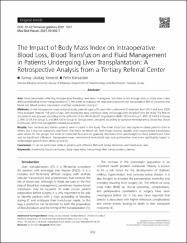| dc.contributor.author | Uludağ Yanaral, Tümay | |
| dc.contributor.author | Karaaslan, Pelin | |
| dc.date.accessioned | 2021-09-16T06:42:32Z | |
| dc.date.available | 2021-09-16T06:42:32Z | |
| dc.date.issued | 2021 | en_US |
| dc.identifier.citation | Uludağ Yanaral, T. ve Karaaslan, P. (2021). The impact of body mass index on intraoperative blood loss, blood transfusion and fluid management in patients undergoing liver transplantation: A retrospective analysis from a tertiary referral center. Medical Bulletin of Haseki, 59(4), 302-307. https://dx.doi.org/10.4274/haseki.galenos.2021.7247 | en_US |
| dc.identifier.issn | 1302-0072 | |
| dc.identifier.issn | 2147-2688 | |
| dc.identifier.uri | https://dx.doi.org/10.4274/haseki.galenos.2021.7247 | |
| dc.identifier.uri | https://hdl.handle.net/20.500.12511/8184 | |
| dc.description.abstract | Aim: Some parameters affecting intraoperative bleeding have been investigated, but there is not enough data on body mass index (BMI) and bleeding in liver transplantation (LT). We aimed to evaluate the relationship between the pretransplant BMI of recipients and blood loss, blood product transfusion, and fluid replacement during LT.
Methods: In this retrospective cross-sectional study, patients aged >= 18 years who underwent LT between April 2014 and June 2020 were analyzed. Patients <18 years of age, with incomplete data, and those using cell salvage were excluded from the study. The BMI of the patients was grouped according to the definition of the World Health Organization (BMI <18.5 in Group 1, BMI 18.5-24.9 in Group 2, BMI 25-29.9 in Group 3, and BMI >30 in Group 4). Groups were compared according to operative hemodynamics, blood loss, blood transfusion, and fluid management-related parameters.
Results: Two hundred and sixteen patients were included in the study. The mean blood loss was higher in obese patients than in others, but it was not statistically significant. The mean red blood cell, fresh frozen plasma, platelet, and cryoprecipitate transfusions were similar for the groups. The mean IV crystalloid fluid amount gradually shortened from underweight to obese patients but there was no significant difference. Preoperative mean international normalized ratio and prothrombin time were significantly higher in underweight patients than others (p=0.025).
Conclusion: LT can be performed safely in patients with different BMI with similar blood loss and transfusion rates. | en_US |
| dc.language.iso | eng | en_US |
| dc.publisher | Galenos Yayıncılık | en_US |
| dc.rights | info:eu-repo/semantics/openAccess | en_US |
| dc.subject | Anesthesia | en_US |
| dc.subject | Blood Transfusion | en_US |
| dc.subject | Body Mass Index | en_US |
| dc.subject | Hemorrhage | en_US |
| dc.subject | Liver Transplantation | en_US |
| dc.subject | Obesity | en_US |
| dc.title | The impact of body mass index on intraoperative blood loss, blood transfusion and fluid management in patients undergoing liver transplantation: A retrospective analysis from a tertiary referral center | en_US |
| dc.type | article | en_US |
| dc.relation.ispartof | Medical Bulletin of Haseki | en_US |
| dc.department | İstanbul Medipol Üniversitesi, Tıp Fakültesi, Cerrahi Tıp Bilimleri Bölümü, Anesteziyoloji ve Reanimasyon Ana Bilim Dalı | en_US |
| dc.authorid | 0000-0003-3917-8183 | en_US |
| dc.authorid | 0000-0002-5273-1871 | en_US |
| dc.identifier.volume | 59 | en_US |
| dc.identifier.issue | 4 | en_US |
| dc.identifier.startpage | 302 | en_US |
| dc.identifier.endpage | 307 | en_US |
| dc.relation.publicationcategory | Makale - Uluslararası Hakemli Dergi - Kurum Öğretim Elemanı | en_US |
| dc.identifier.doi | 10.4274/haseki.galenos.2021.7247 | en_US |
| dc.identifier.scopusquality | Q4 | en_US |


















